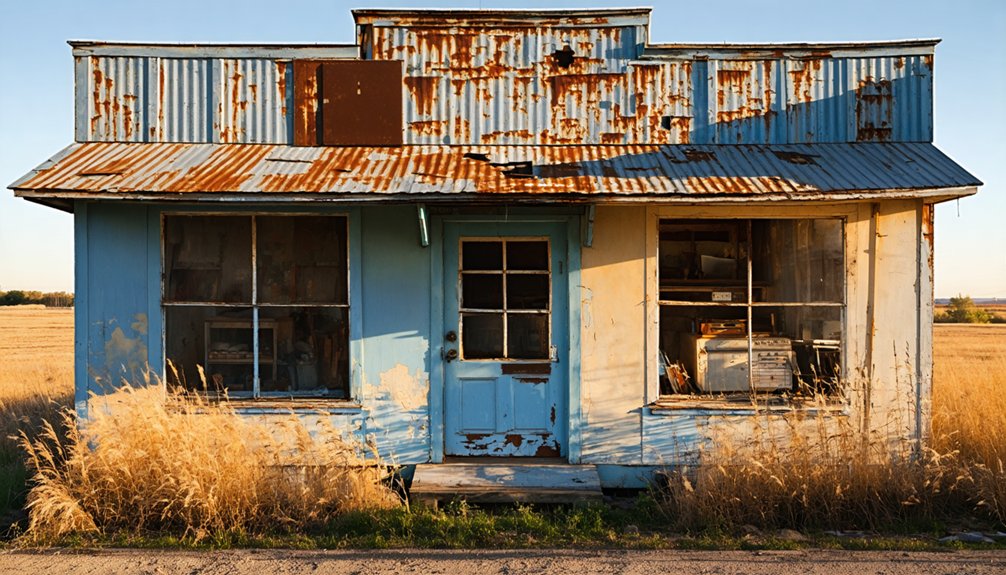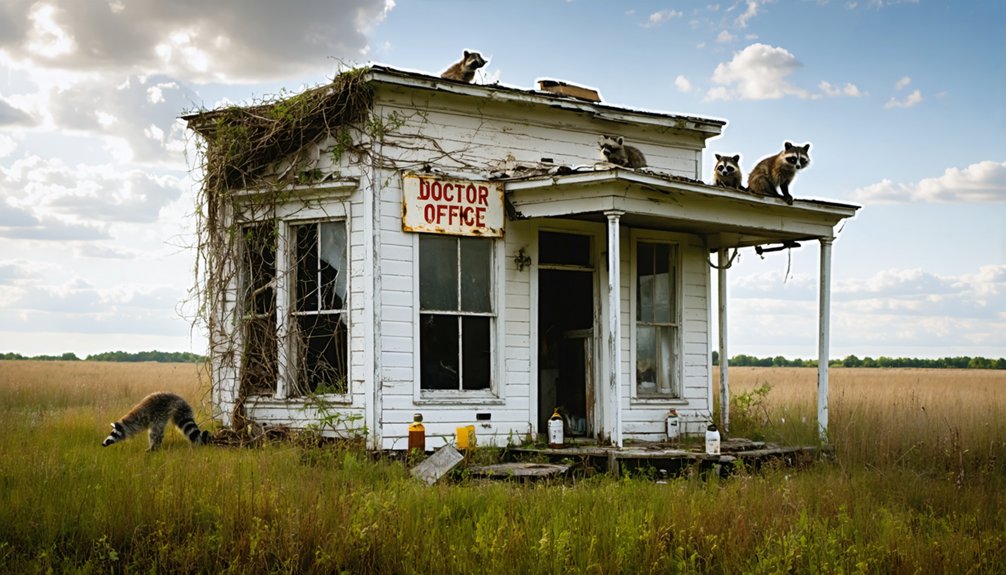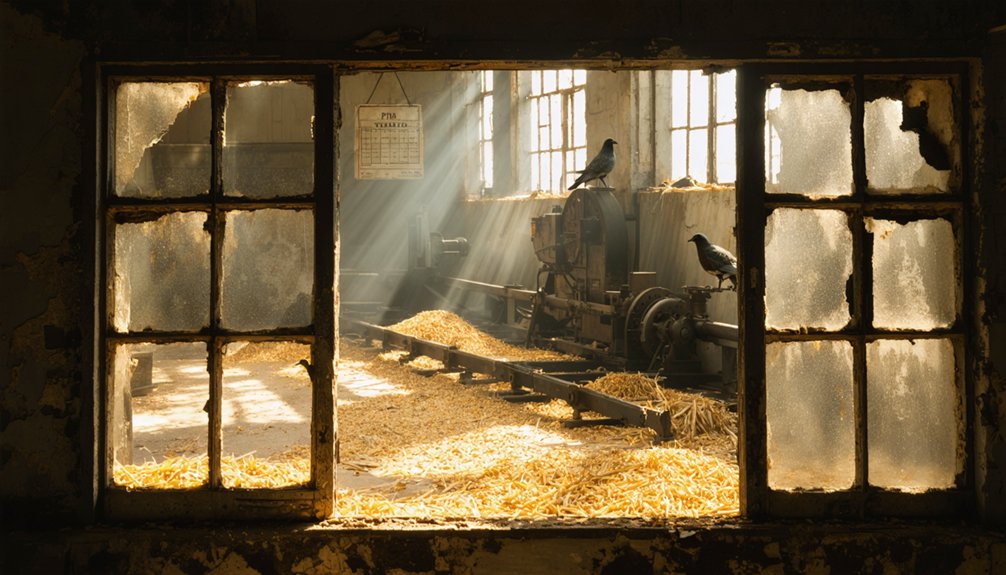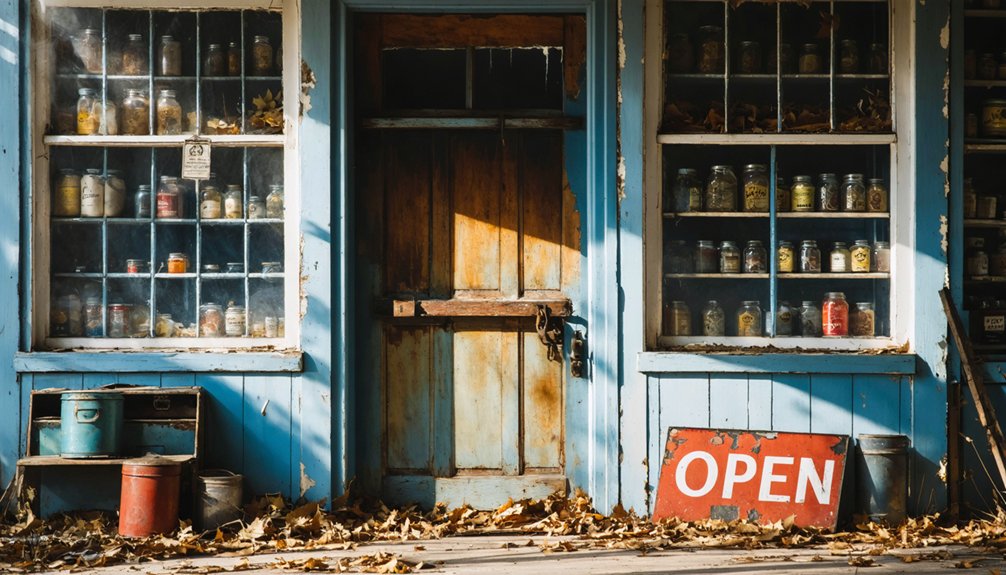Midwest ghost towns exist as time capsules of boom-bust economic cycles, primarily shaped by resource extraction, railroad access, and agricultural challenges. You’ll find abandoned communities that once thrived around mining operations, railroad depots, or farming ventures before facing economic collapse, mechanization, or natural disasters. These forgotten places reveal stories through crumbling structures, overgrown streets, and lonely cemeteries. The patterns of their rise and fall offer compelling insights into the region’s industrial and social history.
Key Takeaways
- Mining booms created thriving communities that became ghost towns when mineral deposits depleted or commodity prices crashed.
- Railroad access determined town survival, with communities that lost rail service often disappearing entirely.
- Natural disasters and disease outbreaks, like 1830s malaria, forced mass abandonments of once-prosperous Midwest settlements.
- Ghost towns serve as time capsules revealing regional industrial history through dilapidated structures and abandoned infrastructure.
- Single-industry dependency left towns vulnerable, as seen in Michigan’s Upper Peninsula mining communities and during the 1980s Farm Crisis.
What Defines a Midwest Ghost Town?

Remnants of forgotten communities dot the Midwest landscape, serving as tangible reminders of economic booms and busts that once shaped the region.
You’ll recognize these abandoned settlements by specific abandonment criteria: the absence of their original economic purpose and minimal or zero population compared to their heyday.
Settlement characteristics typically include dilapidated structures, crumbling foundations, overgrown streets, and lonely cemeteries—physical evidence of lives once lived.
Among the ruins, each fallen beam and weathered headstone whispers stories of those who called this place home.
While some ghost towns stand completely deserted, others maintain skeletal populations, shadows of their former vibrant communities.
What makes these places fascinating isn’t just their emptiness, but how they’ve become time capsules of regional history.
Many Midwest ghost towns emerged when resource depletion forced the closure of mines and other extractive industries that once sustained these communities.
Whether fully abandoned or clinging to existence, these towns reveal industrial and social narratives unique to the Midwest’s development and decline.
WikiProject Ghost Towns aims to improve coverage of these defunct settlements across the United States and worldwide.
The Rise and Fall of Mining Communities
You’ll find the Midwest’s ghost towns often began as resource extraction communities, where discoveries of copper, iron, and coal transformed rural landscapes into bustling industrial centers.
These communities flourished rapidly, as evidenced by Sheridan County’s population quintupling from 1,559 to 8,408 between 1900 and 1910, with mining camps housing an additional 10,000 residents. Most miners were immigrants from central and eastern Europe, bringing their cultural traditions that still influence the region today. Michigan’s Upper Peninsula saw similar prosperity with copper mines driving town development until resources were depleted.
When resources depleted and eastern financiers withdrew their capital, these once-vibrant communities emptied, leaving behind abandoned infrastructure as silent testimony to the boom-bust cycle that defined their existence.
Hidden Wealth Underground
Beneath the seemingly unremarkable soils of the Midwest lay vast mineral deposits that would transform the region’s economic landscape throughout the late 19th and early 20th centuries.
These hidden treasures, particularly iron ore in Michigan’s Gogebic Range and Minnesota’s Mesabi Range, sparked dramatic booms when discovered by pioneers like the Merritt family in 1890.
Extracting these underground resources required massive capital investment—specialized railroads, ore-loading docks, and fleets of lake boats to transport minerals to industrial centers like Chicago.
The Merritt family’s discoveries led to the formation of the Duluth, Missabe and Northern Railroad in 1891, establishing crucial transportation infrastructure for the region’s ore.
The wealth generated was substantial but fleeting. Towns flourished briefly around high-grade deposits, then faced decline when ores depleted.
After WWII, innovation enabled processing of lower-grade taconite, temporarily reviving some communities, but most mining towns remained vulnerable to market forces.
Their rise and fall illustrates the perilous dependency on single-commodity economies.
Prior to European settlement, Native Americans had mined copper along Lake Superior for thousands of years, establishing extensive trade networks that reached the Rocky Mountains and Gulf Coast.
Boom-Bust Mining Cycles
The dramatic cycle of prosperity and decline that characterized Midwest mining communities followed a predictable yet devastating pattern throughout the late 19th and early 20th centuries.
You’ll find these towns initially experienced meteoric growth after mineral discoveries—whether coal, salt, or metals—creating vibrant communities virtually overnight.
Unlike mining economics in western states, Midwest operations often supported diverse industries including timber and agriculture, yet this rarely prevented their ultimate decline. Similar to Nevada’s history, these areas experienced significant boom-bust cycles that defined their economic landscapes for generations.
When deposits depleted or commodity prices crashed, these once-thriving centers emptied rapidly. Community resilience was tested as schools closed, businesses shuttered, and families departed.
The Delaware Copper Mine in Michigan’s Upper Peninsula represents this phenomenon perfectly, once supporting over a thousand residents before its inevitable collapse.
What makes Midwest ghost towns distinctive is their repeating boom-bust pattern, with multiple resource industries failing sequentially despite diversification attempts, leaving behind archaeological treasures that document America’s industrial growing pains.
How Railroad Access Shaped Town Survival

When examining the fate of Midwest ghost towns, railroad access emerges as perhaps the most decisive factor in determining which settlements thrived and which faded into obscurity.
Railroad expansion literally put towns on the map, creating instant communities around depots and junctions while connecting them to national markets.
You’ll find that towns maintaining rail service developed economic resilience through diversified businesses—from blacksmith shops to mills—that supported local industries like iron smelting and agriculture.
When rail lines were abandoned or rerouted, especially after World War II, communities rapidly collapsed. Without access to markets or essential services, businesses shuttered and residents departed.
The pattern becomes clear: settlements that secured continuous rail access survived market fluctuations, while those bypassed by both rails and later highways vanished into historical footnotes. Quindaro exemplifies this pattern, peaking at 600 residents in the early 1900s before gradually declining as transportation networks evolved.
The ghosts of these forgotten communities can still be traced along the Wabash Trace Nature Trail, where abandoned towns like Neoga, Dumfries, and Strahan stand as silent testimony to the boom-and-bust cycle of railroad economics.
Agricultural Failure and Population Exodus
Agricultural decline has devastated countless Midwest communities since the mid-20th century, triggering widespread population exodus and town abandonment.
You’re witnessing the consequences of agricultural consolidation—the Midwest lost over 30,000 farms since 2017, with Wisconsin alone seeing nearly 10% of its farms disappear.
Economic crises have accelerated rural depopulation. During the 1980s Farm Crisis, equipment manufacturers laid off thousands, while communities like Waterloo, Iowa lost 14% of their population.
For every four farms foreclosed, another rural business shuttered.
Meanwhile, developmental pressures consume farmland—suburban sprawl has claimed over 155,000 acres in Illinois alone.
Mechanization further reduces labor needs, driving migration to urban centers.
When farming operations fail, entire communities often follow, leaving behind the ghost towns you’ll encounter throughout the region.
Disease and Disaster: When Nature Forced Abandonment

Natural disasters and disease outbreaks have systematically emptied countless Midwest communities throughout history, leaving behind hollow shells where thriving towns once stood. You can trace the abandonment of settlements like Sinipee, Wisconsin to devastating malaria outbreaks in the 1830s, where mosquito-breeding puddles from melting snow decimated populations.
Flooding events, particularly along river settlements, forced mass relocations when infrastructure couldn’t withstand nature’s force. The isolation of these communities magnified their vulnerability—limited medical facilities meant cholera and typhoid spread unchecked through contaminated water supplies.
When disaster struck, wooden structures collapsed, roads washed out, and railroads were severed, cutting off critical supply lines and escape routes. For many communities, the death toll from these calamities simply exceeded their capacity to rebuild and persist.
Religious Settlements That Faded Away
While disease and natural disasters claimed many Midwest settlements, religious fervor both built and ultimately dismantled numerous communities across the region’s landscape.
You’ll find these 19th-century towns were established by various denominations seeking refuge to practice their faith freely, with churches serving as central hubs for worship and community cohesion.
What’s fascinating is how these religious utopias collapsed. Towns like Voree, Wisconsin crumbled after leadership controversies, while others dissolved when economic foundations failed.
In places like Boston, Ohio, unusual church architecture featuring Gothic Revival elements spawned legends that overshadowed actual religious practices.
Even abandoned, these settlements maintain cultural significance—Central Mine’s Methodist church in Michigan still hosts annual services, demonstrating how spiritual bonds endure long after the physical community has disappeared.
Forgotten Industries That Once Thrived

The Midwest’s ghost towns reveal an economic landscape once dominated by industries that flourished briefly before vanishing into history.
When you explore these abandoned places, you’ll find evidence of single-industry economic dependencies that couldn’t survive market shifts.
Mining towns like Michigan’s Upper Peninsula copper settlements boomed until resources depleted, leaving behind shaft openings and crumbling infrastructure.
Walking through these abandoned mining towns reveals nature slowly reclaiming what humans hastily built during the copper rush.
U.S. Steel’s creation of Gary, Indiana exemplifies how manufacturing established entire communities vulnerable to industrial decline when factories relocated overseas.
Lumber operations built towns that vanished after forests were harvested or mills burned, as happened in Edgewater.
Even salt production and agricultural communities withered when faced with regional competition and changing markets.
These ghost towns serve as stark reminders of how quickly prosperity can vanish when tied to a single resource.
Exploring the Remnants: What’s Left to See
Wandering through Midwest ghost towns today, you’ll encounter a haunting array of physical remnants that tell the story of once-vibrant communities.
Standing structures—general stores, blacksmith shops, churches—persist in various states of decay, particularly in Level 3 or 4 ghost towns where some residential homes remain intact though unoccupied.
The abandoned architecture reveals itself in layers: visible buildings first, then foundations and archaeological remains hidden beneath vegetation.
Cemeteries often survive as silent testimonies to former residents, with weathered gravestones preserving names otherwise forgotten.
Infrastructure fragments—old rail lines, street layouts, water towers—map the town’s original footprint and historical significance.
Some sites benefit from preservation efforts by historical societies or government agencies, offering restored buildings or interpretive materials that illuminate the past while allowing you to experience these time capsules firsthand.
Photography and Documentation Techniques

To capture Midwest ghost towns effectively, you’ll need a DSLR or mirrorless camera with wide-angle lenses, a sturdy tripod, and powerful lighting tools for exploring abandoned structures safely in remote locations.
The distinctive rust, peeling paint, and structural decay become visually compelling subjects when photographed during golden hours, when directional light accentuates textures and creates dramatic shadows across weathered facades.
Consider experimenting with both color photography to document historical accuracy and black-and-white techniques to emphasize the timeless quality of these forgotten settlements, while employing long exposures to capture ethereal effects that convey the haunting atmosphere of abandonment.
Capturing Decay Beautifully
Amid the haunting silence of Midwest ghost towns, photographers discover unique opportunities to document architectural decay through thoughtful composition and technical skill.
You’ll capture the essence of decay aesthetics through exposure bracketing, which preserves details in both shadows and highlights. Utilize your tripod for stability during low-light and long-exposure shots that reveal the gradual reclamation of structures by nature.
During urban exploration, focus on small objects—rusted keys, scattered tools, abandoned toys—that tell powerful stories about former inhabitants.
Weathered textures and architectural features gain prominence through monochrome conversion, which accentuates the emotional weight of deterioration. Creative angles and vignetting techniques draw viewers’ attention to central subjects while maintaining the authentic character of these forgotten spaces.
The beauty in decay emerges through patient documentation of time’s relentless march.
Light and Shadow Techniques
Light and shadow form the expressive language through which ghost towns reveal their stories to your camera.
During golden hours, position yourself between subject and light source to capture dramatic silhouettes against fiery skies, emphasizing the haunting shapes of abandoned structures.
For night photography, master light painting with handheld flashlights and colored gels during long exposures (10-30 seconds). This technique selectively illuminates textures while maintaining the eerie atmosphere that makes these locations compelling.
Balance natural and artificial light sources—moonlight with subtle artificial illumination preserves authenticity.
Side lighting accentuates texture while shadows create depth and mystery.
For effective silhouette storytelling, shoot in manual mode with a tripod, using wide apertures (around f/4) to maintain sharpness while emphasizing the interplay between illuminated features and shadow-draped secrets of these forgotten places.
Equipment for Remote Locations
Venturing into the isolated remnants of Midwest ghost towns requires specialized equipment that balances functionality with portability. Your primary tool should be a DSLR or mirrorless camera with manual camera settings to navigate the challenging light conditions in abandoned buildings.
Pair it with versatile lens choices: wide-angles for capturing sweeping architectural remains and primes for detail work on artifacts.
Since power access is nonexistent, pack extra batteries and portable chargers or solar options for extended shoots. A sturdy yet lightweight tripod is essential for low-light interiors and night photography.
Consider weather-sealed gear to protect against dust and unexpected weather shifts. Include headlamps and portable LED lighting to illuminate dark corners.
Finally, don’t forget documentation tools—GPS devices, notebooks, and voice recorders to capture location data and contextual information for your post-processing workflow.
Planning Your Ghost Town Road Trip
Before starting your Midwest ghost town expedition, thorough research and strategic planning will greatly enhance both safety and enjoyment.
Balance your itinerary between iconic locations along historic routes like Route 66 and lesser-known gems hidden in the Upper Peninsula’s wilderness. Map out towns with diverse historical backgrounds—mining outposts, railroad hubs, and lumber communities—to experience the full spectrum of ghost town legends.
A journey through America’s forgotten places reveals history’s whispers in both famous routes and wilderness hideaways.
When charting your course, factor in travel times between remote locations, especially in regions like the Keweenaw Peninsula where amenities may be 100+ miles apart. Incorporate nearby functioning towns with accommodations and supplies to support your urban exploration adventures.
Always communicate your route with someone before departure and prioritize daylight exploration to navigate deteriorating structures safely. Check property permissions to avoid trespassing issues.
Frequently Asked Questions
Are There Legal Consequences for Removing Artifacts From Ghost Towns?
Yes, you’ll face severe legal consequences. Removing artifacts destroys historical significance and violates federal and state laws, resulting in hefty fines, imprisonment, and equipment confiscation. Prioritize artifact preservation instead.
How Do Local Residents Feel About Ghost Town Tourism?
Local opinions on ghost town tourism are mixed. You’ll find some residents appreciate tourism benefits like economic opportunities, while others worry about historical accuracy, potential vandalism, and disruption to nearby communities.
Can Metal Detectors Be Used at Midwest Ghost Town Sites?
You can use metal detecting techniques at some Midwest ghost town sites, but you’ll need permissions for private land and permits for public areas of historical significance. Many locations legally restrict this activity.
Which Ghost Towns Have Paranormal Activity or Haunting Legends?
You’ll find notable paranormal activity in Villisca Axe Murder House, Stull Cemetery, and Alton, Illinois—all sites of tragic history where paranormal investigations frequently document haunting legends through EVP and apparition evidence.
Are There Seasonal Considerations When Visiting Midwest Ghost Towns?
You’ll encounter significant weather variations affecting Midwest ghost towns. Summer and spring offer ideal accessibility, while winter brings road closures. Fall provides colorful backdrops but presents increasingly unpredictable conditions.
References
- https://pbswisconsin.org/news-item/southern-wisconsins-ghost-towns-leave-behind-vital-stories/
- https://en.wikipedia.org/wiki/Wikipedia:WikiProject_Ghost_towns
- https://www.geotab.com/ghost-towns/
- https://www.youtube.com/watch?v=5Z5Vv-eeieY
- https://www.nps.gov/slbe/learn/historyculture/ghosttowns.htm
- https://m.dresshead.com/files/scholarship/Documents/Ghost_Towns_Lost_Cities_Of_The_Old_West_Shire_Usa.pdf
- https://jrap.scholasticahq.com/api/v1/articles/9543-the-economics-of-ghost-towns.pdf
- https://noospheregeologic.com/blog/tag/ghost-towns/
- https://www.lovemoney.com/gallerylist/86648/americas-empty-ghost-towns-and-why-theyre-abandoned-today
- https://en.wikipedia.org/wiki/Wikipedia:WikiProject_Ghost_towns/Assessment



